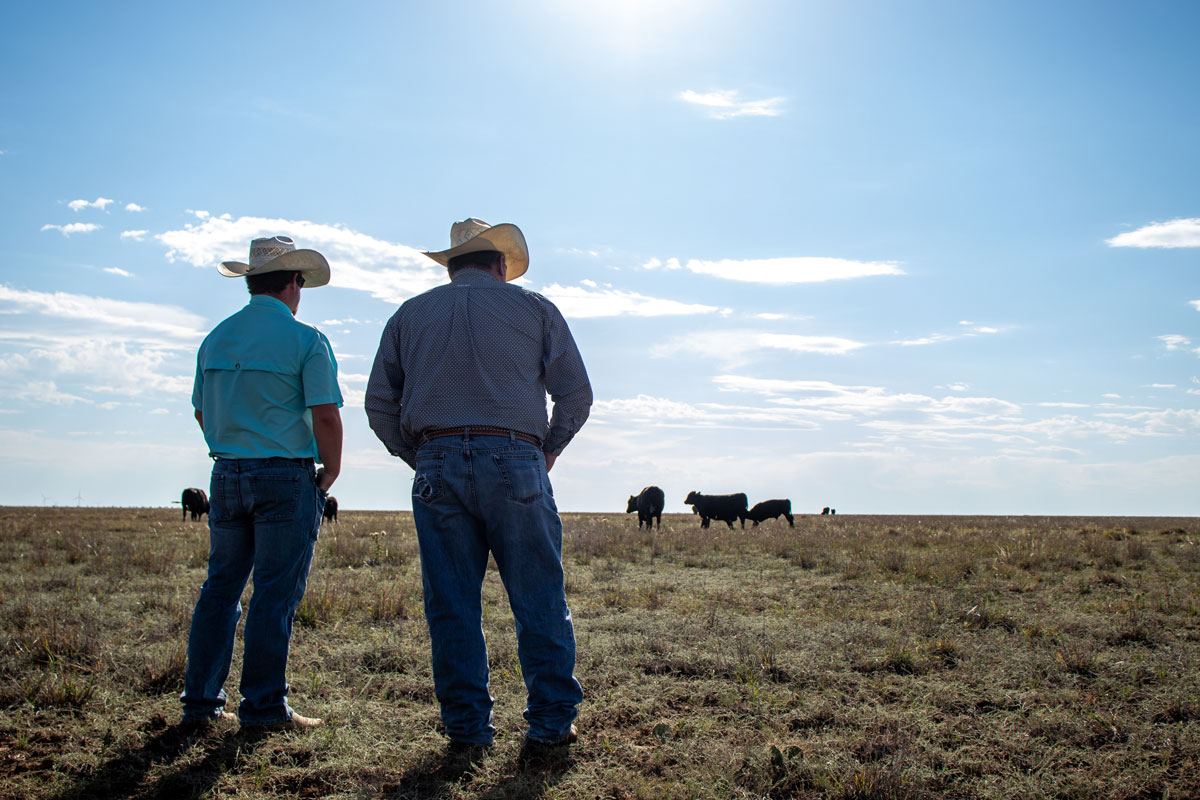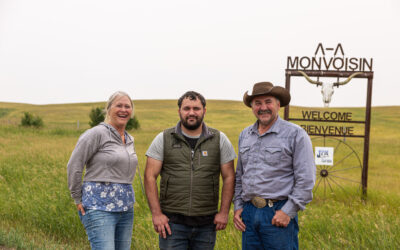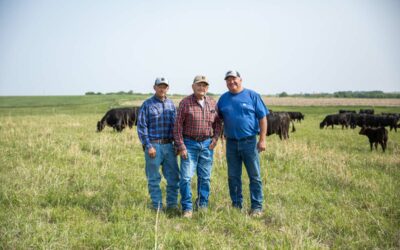
Home-raised Angus
Business breed brightens future for Bootleg (Texas) Bradleys
by Maeley Herring
June 14, 2021
Farm-to-Market Route 1058 crosses Texas Highway 214 at a little place called Bootleg on the staked plains 30 miles west of Hereford, half that far from the New Mexico line.
It’s an arid place, where cattleman Tod Bradley grew to his teens on a ranch his family leased while buying parcels of their own. Moved back to Dimmitt then, where granddad Dent Bradley had opened the first grower yard in the 1940s, he wasn’t surprised when dryland farmers began signing up for USDA’s 10-year Conservation Reserve Program (CRP) in the late 1990s.
“You knew what you were going to get, whereas the rains came, or not,” says Bradley. He quotes a local saying: “When the good Lord flooded the world, we got just a shower out here.”
An occasional blizzard or 4-inch rain can break the pattern, but not for long. Still, the Bradleys love the land and stay for the opportunity land and cattle provide.
Recently, that involved expiring CRP land north of Bootleg, which led to trying cow-calf pairs.
Today, three generations of the family run three cattle enterprises from the cows here to an expanded backgrounding yard at Dimmitt and finishing at Tulia, Texas. Maternal granddad G.L. Willis pioneered the large-scale feedyard initiatives.
Bradley oversees those operations with help from his dad Gene and son Beau. His Brother Zay raises the wheat and corn on irrigated farmland that goes to feed the cattle.
“We are mainly feedyard and stocker people,” Bradley says. “But when all the CRP grass started coming out, I couldn’t make those yearlings do very good on it.”
Cows could do better than stockers on the coarse, old-world bluestem – and make a living on 15 acres, less than half that needed on the native short grass. He began with “hodgepodge cows of every shape and size.”
Soon seeing promise but a need for more uniform quality, the cattleman sold the trial herd and bought some Angus-base cows out of Wyoming and the Dakotas, which now comprise a herd that produces 500 Angus-sired calves each spring.

“Angus get such big premiums on their grade and yield compared to other breeds, and they’re pretty tough for this country. I’ve tried a few Charolais bulls, trying to get a little more yield out of them,” Bradley admits. But the crossbreds pick up little dressed yield and “just one pound more carcass weight,” not worth the trade for predictability.
Bradley buys registered bulls from the Knoll family’s 2 Bar Angus at Hereford, Texas, because they meet performance goals at each phase from Bootleg’s CRP pastures to the stocker, feedyard and beef packer’s grid.
“We never sell our calves, feed them all,” Bradley says.
Home-raised calves wean into grass traps for 45 days when the bigger half go on to the finishing yard while the rest grow to six-weights on wheat pasture first.
Once they finish at 16 months, at least 85% grade Choice or better with an increasing share making the Certified Angus Beef ® (CAB®) brand, including Prime.
A check of pen performance last summer found an average daily gain of 4.65 pounds (lb.), Bradley says. Ironically, that’s almost too fast: “If we don’t get them on feed by the time they weigh 650 lb., we struggle to get enough days on them to grade before they get too heavy and we risk losing all our premiums on the grid.”
Last year’s market disruptions meant selling cash cattle as the only deal available, typically giving up $7 to $10 per hundredweight for a while. Meanwhile, some of the 2020 calves had to be weaned early because of drought, but they handled the adjustment well.
Shifting cattle and plans is a constant theme, but all part of Bradley’s masterplan that is staying flexible and keeping up with new ideas. Genetics play a key role, always advancing.
“The cow man can try to get a better calf-crop percentage, or a feeder can get his calves to marble faster and weigh more on less feed or lesser quality feed,” he says.
The bulls bought a few years ago “are nearly obsolete” to those Bradley uses today, he says.

“When you look at their performance numbers– like dollars beef ($B), 200 was unheard of four or five years ago, but they are out there now and Steve (Knoll) has them,” he says. More than advanced genetics, he says Knoll understands his needs and helps find solutions for any issues that come along.
That’s important with West Texas scale and risk, buying thousands of cattle from Mexico to fill the finishing yard and graze the 6,000 acres of wheat alongside family-raised calves. It often means long days from pre-dawn till dark, but generations of Bradleys wouldn’t have it any other way. His daughters Raynee and Taylor worked in feedyard offices, and wife Cindy does, too.
“Horses, roping and cattle – by the time we could walk, we could ride – and the people out here – we just love it every day,” Bradley says. “Dad taught us it’s about family more than just the work. Now we have three generations working together, and Mom (Shari) still cooks lunch at her house every day.”
Underlying all is the land, “what my family has made a living off of, what we take care of so it will take care of us,” he says. “You have to be willing to endure the extra expense and effort to shuffle cattle around and protect the forage and soil.”
Granddaughter Carter Sue, going on three, is blazing a trail for the next generation. Well used to riding a horse, she likes getting a heifer for a birthday present and already puts in long days learning and living a legacy with her family.
“This lifestyle is all I’ve ever known, and it’s something I am proud to pass along,” Bradley says.
Originally ran in the Angus Journal.
You may also like
Saskatchewan Angus Ranch Earns Certified Angus Beef Award
JPM Farms in Canada quietly gained recognition for its dedication to environmental sustainability and quality cattle. The Monvoisin family earned the 2023 CAB Canadian Commitment to Excellence award for their outstanding results and partnership with Duck Unlimited, showcasing their commitment to improving the land, cattle and family daily.
Benoit Angus Ranch honored with CAB Seedstock Commitment to Excellence Award
What started with six Angus heifers, has now grown into 400 Angus females, along with a 2,500 acre farming division. The multi-generation family business focus on improving the reputation on the ranch with high-quality cattle. From the ground up, Benoit Angus Ranch has earned the CAB 2023 Seedstock Commitment to Excellence Award.
Everything They Have
Progress is a necessity on the Guide Rock, Nebraska, ranch where Troy Anderson manages a commercial Angus herd, small grower yard, his 10-year-old son, and a testing environment. Troy’s approach includes respect for his livestock, people and land. For that, Anderson Cattle was honored with the CAB 2023 Commercial Commitment to Excellence Award.



